In an industry where innovation and efficiency reign supreme, the continuous operation waffle iron plant stands out as a testament to the seamless fusion of modern technology and timeless tradition. This unique facility not only churns out waffles in an uninterrupted stream but also represents a beacon of progress in the baking industry. As we delve into the intricacies of such a plant, it becomes clear that it’s more than just a factory—it’s a marvel of modern engineering and a cornerstone of the market. Join us as we explore the wonders of the continuous operation waffle iron plant and its significance in the ever-evolving world of consumer goods.
The Perks of a Continuous Operation Waffle Iron Plant
Operating a waffle iron plant that runs continuously offers a multitude of advantages, from increased productivity to enhanced customer satisfaction. Here’s a closer look at some of the key benefits that come with such a setup.
Firstly, the ability to produce waffles around the clock means that demand can be met swiftly and efficiently. This non-stop operation ensures that there’s always a fresh batch of waffles ready for consumers, regardless of the time of day. It’s a game-changer for businesses looking to capitalize on peak hours and cater to the needs of a 24⁄7 society.
Secondly, the consistency in output is unparalleled. With a continuous operation, the waffle iron plant can maintain a steady flow of products, ensuring that the quality and taste of each waffle remain consistent. This reliability is crucial for brands that aim to establish a reputation for excellence and repeat purchases.
Moreover, energy efficiency is a significant advantage. Continuous operation plants are designed to minimize energy waste. By optimizing the use of heat and electricity, these facilities can reduce their carbon footprint and operational costs. This not only benefits the environment but also contributes to the bottom line of the business.
The scalability of a continuous operation waffle iron plant is another perk. As the market demand grows, the plant can easily adjust its production capacity without significant downtime. This flexibility allows businesses to stay ahead of the curve and adapt to changing consumer preferences without disrupting their operations.
Safety is paramount in any manufacturing environment, and continuous operation plants are no exception. Advanced safety protocols are implemented to ensure that the equipment runs smoothly and without incident. This includes regular maintenance checks, automated safety systems, and well-trained staff who are prepared to handle any unforeseen issues promptly.
Another benefit is the reduction in labor costs. While some may assume that a continuous operation requires a larger workforce, the opposite is often true. The automation and streamlined processes allow for fewer employees to manage the production line, which can lead to substantial savings over time.
Customer satisfaction is a cornerstone of any successful business, and a continuous operation waffle iron plant plays a pivotal role in achieving this. The ability to provide a steady supply of high-quality waffles means that retailers and foodservice providers can stock up without worrying about stockouts. This reliability ensures that customers can always find their favorite waffles on the menu.
The plant’s design also allows for easy integration with supply chains. With a continuous flow of products, logistics become more efficient, reducing lead times and improving inventory management. This integration can lead to cost savings and a more seamless operation from production to distribution.
Innovation is another byproduct of continuous operation. The need to maintain efficiency and quality drives the development of new technologies and processes. This means that the waffle iron plant can stay at the forefront of industry advancements, offering cutting-edge products that stand out in the market.
Furthermore, the plant’s design can be tailored to specific product requirements. Whether it’s producing traditional Belgian waffles or unique, artisanal flavors, the continuous operation setup can accommodate various recipes and designs without compromising on consistency.
Lastly, the potential for data-driven insights is immense. With a continuous operation, the plant generates a wealth of data that can be analyzed to improve processes, predict trends, and make informed decisions. This data-driven approach can lead to better resource allocation, more efficient production schedules, and ultimately, a more profitable business.
In conclusion, the perks of a continuous operation waffle iron plant are numerous. From meeting consumer demand to reducing costs and improving safety, these benefits make it a compelling choice for businesses looking to thrive in the competitive waffle market.
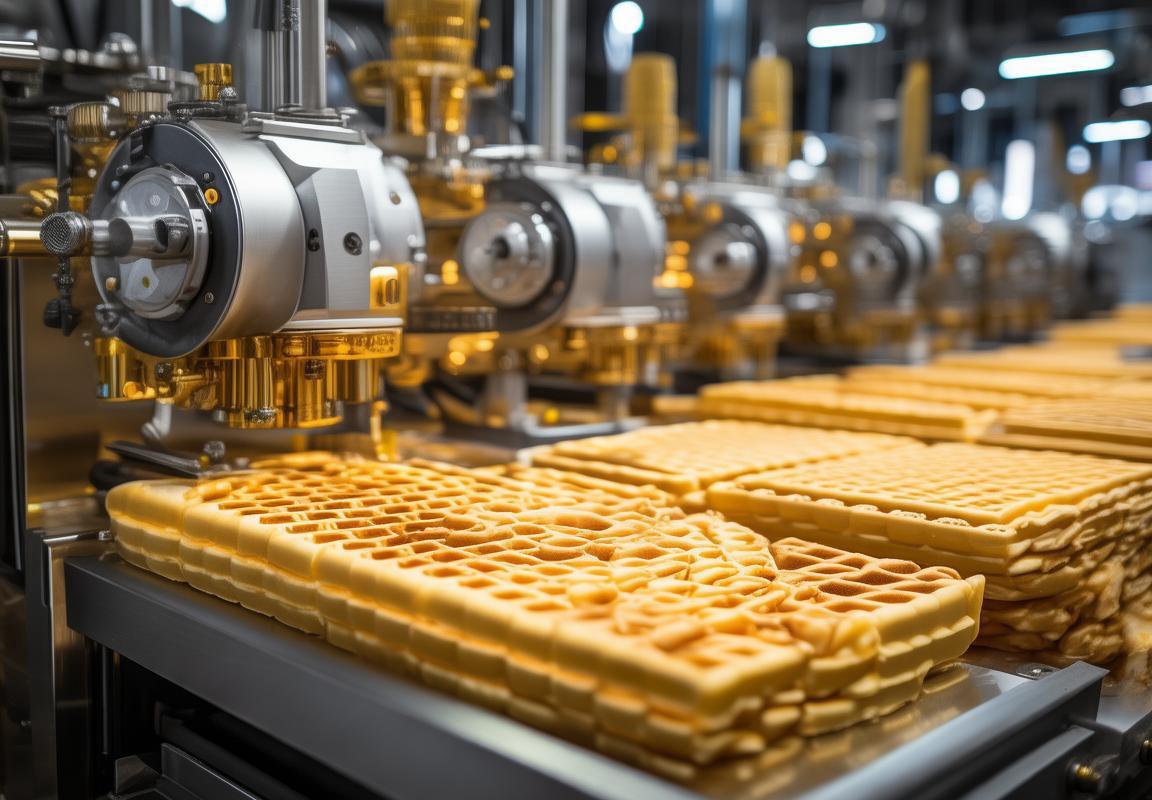
How It Works: A Closer Look at the Process
A continuous operation waffle iron plant is a marvel of modern food manufacturing, designed to churn out waffles at a steady pace without interruption. Let’s delve into the intricate process that makes this possible.
The heart of the operation is the automated conveyor system. Waffles begin their journey on a stainless steel belt that runs through the plant. As they move, they are coated with batter, which is precisely measured and applied to ensure uniformity. This system is crucial for maintaining the quality and consistency of each waffle that comes off the line.
Once the batter is applied, the waffles are guided into the waffle iron. These irons are often equipped with timers and sensors to regulate the cooking process. The temperature and pressure are carefully controlled to achieve the perfect balance of crispness and moisture. The irons are designed to heat up quickly and maintain a consistent temperature throughout the production cycle.
After the waffle is cooked, it is swiftly transferred to a cooling station. This is essential to prevent the waffles from sticking together and to ensure they cool down to a safe temperature for packaging. Airflow systems are used to expedite the cooling process, allowing the waffles to reach room temperature in a matter of minutes.
In the packaging area, automated machines take over. The cooled waffles are individually wrapped in a protective layer of parchment paper or foil. This not only preserves freshness but also prevents the waffles from absorbing any odors from other products in the facility. The wrapping process is designed for speed and efficiency, with a high-speed printer applying labels and barcodes as the waffles move along the conveyor belt.
As the wrapped waffles exit the packaging area, they pass through an automated inspection station. Here, high-resolution cameras scan each waffle for any defects, such as uneven baking or tears in the wrapper. Any waffles that fail the inspection are automatically discarded, ensuring that only the highest quality products reach the consumer.
The entire production line is controlled by a central computer system. This system manages the flow of waffles through each stage of the process, adjusting the conveyor speeds and machinery settings as needed to maintain production rates and quality standards. It also provides real-time data on production output, allowing for quick adjustments if there is a deviation from the desired pace.
To prevent downtime, the plant is designed with redundancy in mind. Critical components, such as motors and heating elements, are duplicated so that if one fails, the other can take over without halting production. This redundancy extends to the electrical and mechanical systems, which are built to withstand the rigors of continuous operation.
Energy efficiency is a priority in these plants. Modern waffle irons are designed to minimize energy consumption while still providing the necessary heat for cooking. The plant’s electrical systems are optimized for efficiency, with smart energy management systems that adjust power usage based on demand.
In terms of maintenance, the continuous operation waffle iron plant is equipped with predictive maintenance tools. These tools monitor the health of the machinery and alert operators to potential issues before they become problems. This proactive approach helps to minimize unplanned downtime and keep the plant running smoothly.
Safety is paramount in such a fast-paced environment. The plant is equipped with various safety features, including emergency stop buttons, fire suppression systems, and ergonomic designs that reduce the risk of operator injury. Regular safety training and inspections ensure that all personnel are aware of the protocols in place.
The process of producing waffles in a continuous operation plant is a testament to the ingenuity and precision of modern manufacturing. From the moment batter is applied to the waffle iron to the moment it is packaged and inspected, every step is carefully managed to ensure that the final product meets the highest standards of quality and consistency. This meticulous process is what allows for the seamless production of millions of waffles every day, a testament to the efficiency and reliability of continuous operation waffle iron plants.
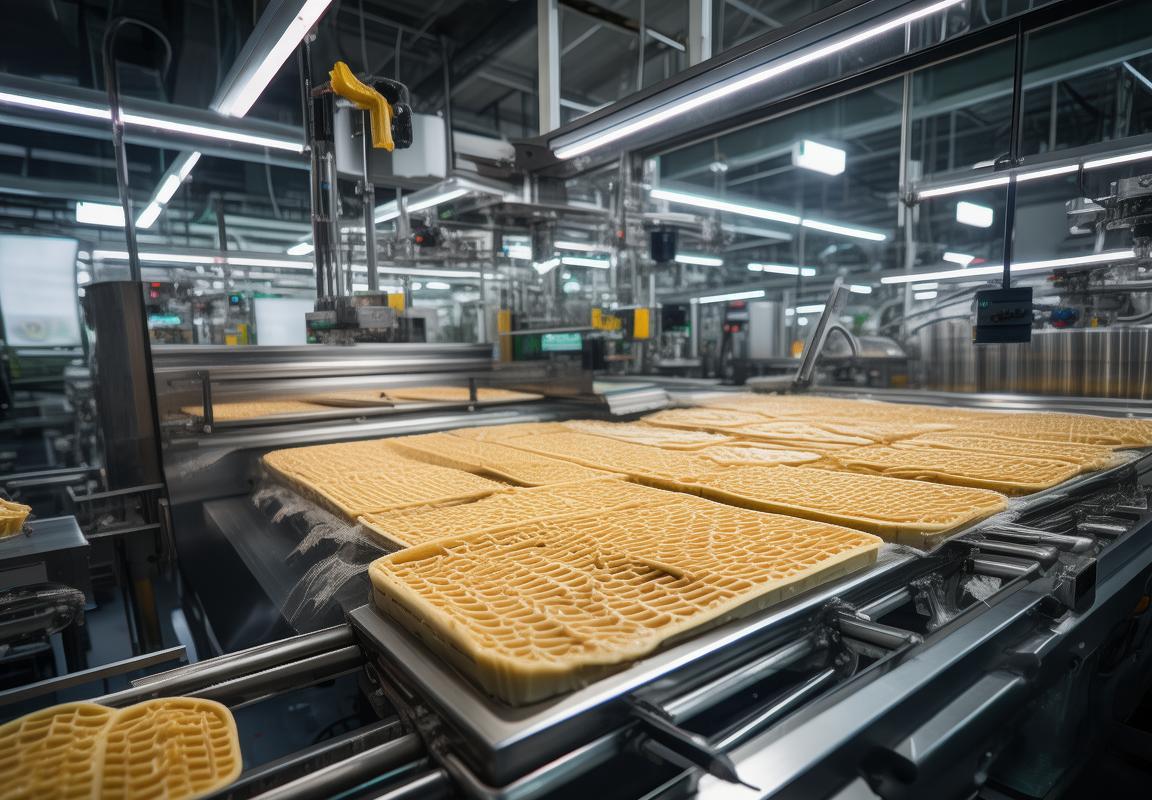
Efficiency and Consistency: The Plant’s Key Benefits
Efficiency and consistency are at the heart of what makes a continuous operation waffle iron plant a game-changer in the food industry. Here’s how these two aspects are achieved and the benefits they bring:
In the heart of the plant, a series of precision-engineered waffle iron units work in harmony to ensure a constant flow of delicious waffles. These irons are designed with heat distribution in mind, using advanced materials that maintain a consistent temperature throughout the cooking process. This means that each waffle comes out with the perfect balance of crispiness and softness, every single time.
The automated nature of the plant allows for a non-stop operation, with batches of waffles being produced continuously without any human intervention. This round-the-clock production means that the plant can meet high demand without faltering, ensuring that retailers and consumers alike always have access to fresh, hot waffles.
One of the standout benefits of such a plant is the ability to maintain a high level of consistency in the product. The automated systems are programmed to the precise specifications needed for each batch, from the temperature at which the waffles are cooked to the duration of the cooking cycle. This ensures that every waffle produced is uniform in size, shape, and quality, which is crucial for brand recognition and customer satisfaction.
The efficiency of a continuous operation waffle iron plant is not just about the quantity of waffles produced but also about the resources it consumes. By automating the process, the plant reduces the need for manual labor, leading to lower labor costs. Additionally, the plant’s design minimizes waste, with a system that captures and recycles excess heat, reducing energy consumption and further cutting down on costs.
The streamlined process also means that the plant can respond quickly to changes in market demand. If there’s a surge in orders, the plant can easily adjust its production capacity to meet the new requirements, ensuring that no opportunity for growth is missed.
Quality control is another area where the plant excels. With each batch of waffles being produced under strict, automated guidelines, the risk of defects is significantly reduced. The plant’s operators can rely on the system to deliver a high-quality product, time after time, which helps to maintain the brand’s reputation and customer loyalty.
Moreover, the plant’s efficiency extends to its maintenance schedule. Regular checks and maintenance are automated to a degree, allowing for predictive maintenance rather than reactive repairs. This means that any potential issues can be addressed before they become a problem, ensuring that the plant runs smoothly and minimizes downtime.
Safety is also a priority in these plants, with safety features integrated into the design from the ground up. Sensors and automated shutdown mechanisms are in place to prevent any accidents or malfunctions, ensuring a safe working environment for the plant’s operators.
In summary, the key benefits of a continuous operation waffle iron plant lie in its efficiency and consistency. From the high-quality, uniform waffles that it produces to its cost-effectiveness and adaptability, the plant is a beacon of modern food production technology. It’s not just about churning out waffles at a high rate; it’s about doing so with precision, reliability, and a focus on the end consumer’s experience.
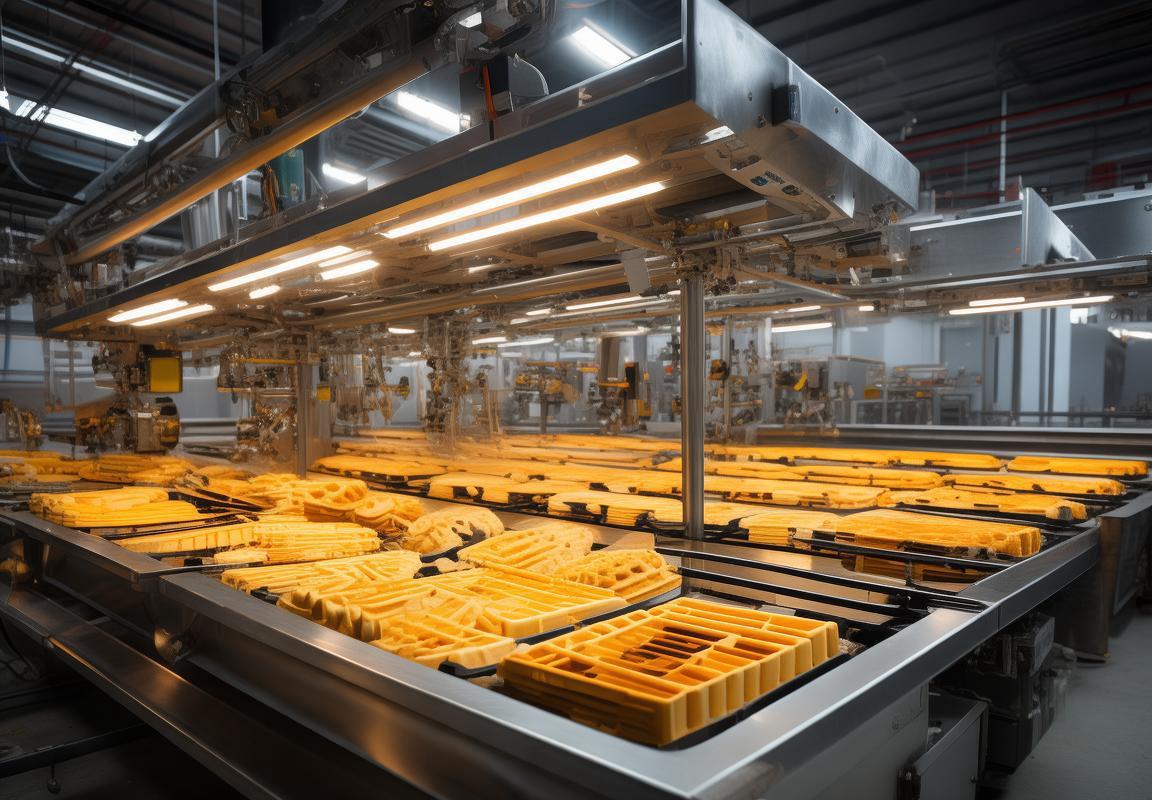
Innovative Design for Non-Stop Waffle Production
The continuous operation waffle iron plant is a marvel of modern engineering, designed to churn out waffles at an impressive rate without missing a beat. Here’s a closer look at the innovative design that makes this non-stop production possible.
The heart of the plant is its automated waffle iron system, which is a far cry from the traditional manual waffle makers you might find in a kitchen. These irons are precision-engineered to ensure uniformity in every waffle produced. The design incorporates features that allow for seamless operation, from the initial loading of the batter to the final product’s exit.
One key aspect of the design is the use of high-quality, heat-resistant materials. The waffle irons are made from durable stainless steel, which can withstand the intense heat required to cook the batter to perfection. The surface of the irons is treated to prevent sticking, ensuring that each waffle releases cleanly without the need for oil or non-stick sprays.
The batter is delivered to the irons through a sophisticated conveyor system. This system is designed to maintain a consistent flow rate, preventing bottlenecks and ensuring that the waffle irons are always ready to receive the next batch of batter. The conveyor system is also equipped with sensors that monitor the flow and adjust it accordingly, keeping the production line running smoothly.
The irons themselves are designed with a unique heating element that distributes heat evenly across the surface. This even heating is crucial for creating the characteristic waffle patterns, which are formed by the iron’s grid-like structure. The heating elements are controlled by a computerized system that adjusts the temperature to the precise degree required for each batch of batter, ensuring that every waffle is cooked to the same golden brown perfection.
One of the most innovative aspects of the design is the inclusion of an automatic cleaning system. After each waffle is cooked, the iron is automatically cleaned to remove any residue from the batter. This not only prevents the buildup of food particles but also ensures that each waffle has the same quality and taste. The cleaning process involves a series of jets that spray a cleaning solution onto the surface of the iron, followed by a drying cycle to ensure no moisture remains.
The plant’s design also takes into account the safety of its operators. The waffle irons are equipped with safety interlocks that prevent them from operating unless all necessary precautions are in place. Additionally, the plant is designed with ergonomic controls that allow operators to monitor and adjust the production process without the need for strenuous physical labor.
Efficiency is a cornerstone of the plant’s design. The entire production process is optimized to minimize downtime and maximize output. The automated system reduces the need for manual labor, which not only speeds up production but also reduces the potential for human error. The result is a high volume of high-quality waffles being produced in a short amount of time.
Consistency is another critical factor. The plant’s design ensures that every waffle meets the same standards of quality. The automated system monitors the cooking process, adjusting the temperature and timing as needed to maintain consistency. This level of precision is something that would be nearly impossible to achieve with manual methods.
The innovative design of the continuous operation waffle iron plant is not just about speed and volume; it’s about quality and reliability. The plant’s ability to produce waffles non-stop is a testament to the ingenuity of its designers, who have created a system that is both efficient and scalable. Whether it’s a small batch or a large-scale production, the plant can adapt to meet the demand, all while delivering a product that is as close to perfect as can be.
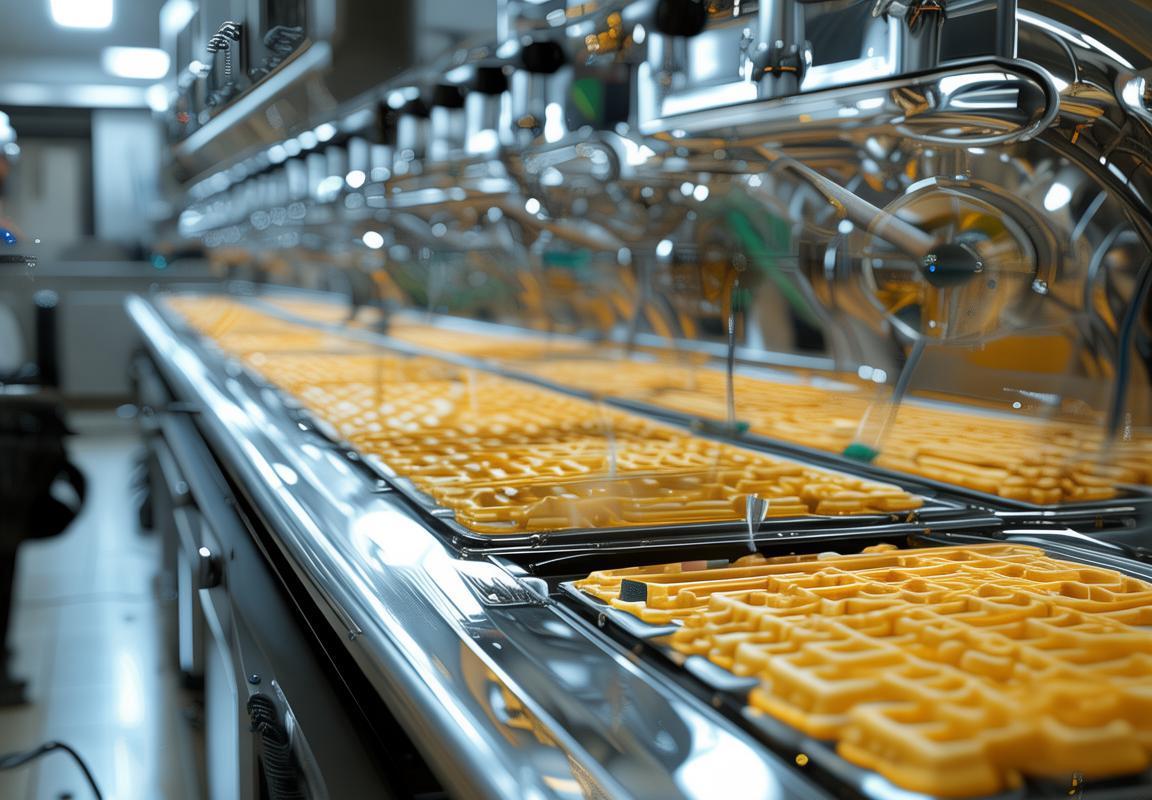
Enhanced Safety Measures in Continuous Operation
In the realm of non-stop waffle production, safety is paramount. Continuous operation waffle iron plants are designed not only for efficiency but also with a robust safety framework that ensures the well-being of employees and the longevity of the equipment. Here’s an in-depth look at the enhanced safety measures in place:
Safety Training ProgramsThe heart of any continuous operation plant lies in the training of its workforce. Employees are rigorously trained to understand the machinery inside and out. This includes safety protocols for operating the equipment, recognizing potential hazards, and responding to emergencies. Regular refresher courses keep the knowledge fresh and the team prepared.
Automated Monitoring SystemsModern continuous operation waffle iron plants are equipped with advanced monitoring systems that keep a constant eye on the equipment’s performance. These systems can detect anomalies in real-time, such as overheating or unusual vibrations, and can trigger immediate alerts. This proactive approach helps prevent accidents and downtime before they become significant issues.
Fire Suppression SystemsGiven the heat involved in waffle production, fire suppression systems are a crucial component. These systems are designed to detect smoke or heat and activate quickly to extinguish fires before they can spread. In some plants, water mist systems are used instead of traditional sprinklers to minimize water damage to the equipment and the surrounding area.
Machine GuardingTo prevent accidents, all moving parts of the waffle iron machinery are enclosed or protected by guards. These guards are designed to withstand impact but can be easily opened for maintenance without the need for tools. Regular inspections ensure that guards remain in good condition and continue to provide the necessary protection.
Emergency Shutdown MechanismsIn the event of a malfunction or an emergency, immediate action is essential. Continuous operation waffle iron plants are fitted with emergency shutdown mechanisms that can be activated manually or automatically in critical situations. These mechanisms are designed to isolate the power supply and stop the machinery safely, reducing the risk of injury.
Ventilation and Air QualityAdequate ventilation is crucial in any production environment to ensure a safe working environment. Continuous operation waffle iron plants are equipped with ventilation systems that remove heat, steam, and fumes, which can be harmful if inhaled in high concentrations. Regular maintenance of these systems ensures that the air quality remains within safe limits.
Personal Protective Equipment (PPE)Employees are provided with the appropriate PPE, including gloves, safety goggles, and ear protection. This equipment is essential for protecting workers from potential hazards such as sharp edges, hot surfaces, and loud machinery. The plant also has a well-stocked first aid kit and trained first responders on site to deal with minor injuries immediately.
Regular Equipment MaintenanceRegular maintenance is key to ensuring the safety of continuous operation waffle iron plants. Scheduled checks and services are performed to identify and address potential issues before they become safety concerns. This includes inspecting electrical systems, mechanical components, and the integrity of safety guards.
Accessibility of Safety FeaturesAll safety features are easily accessible to employees. Emergency exits, fire alarms, and first aid stations are clearly marked and positioned to allow for quick and easy access in case of an emergency. The plant’s layout is designed with safety in mind, minimizing the distance to safety equipment.
Environmental MonitoringContinuous operation waffle iron plants also monitor environmental factors such as temperature and humidity, as extreme conditions can affect the machinery’s performance and the safety of the workforce. These systems alert management to any deviations from the optimal range, allowing for timely adjustments.
Employee Involvement in SafetyThe plant encourages an active role in safety among its employees. Regular safety meetings and briefings keep everyone informed about the latest safety protocols and any changes in the plant’s safety procedures. Employees are encouraged to report hazards or near-misses, fostering a culture of safety.
In conclusion, the continuous operation waffle iron plant employs a comprehensive array of safety measures to ensure that production runs smoothly without compromising the well-being of its staff. From rigorous training and cutting-edge monitoring systems to robust equipment and a proactive approach to maintenance, every aspect of the plant’s operation is geared towards creating a safe and secure work environment.

The Plant’s Impact on the Market and Consumers
In the bustling world of food production, a continuous operation waffle iron plant stands out not just for its ability to churn out waffles at an impressive rate, but also for its profound impact on the market and the consumers it serves. This specialized facility has revolutionized the way waffles are produced and consumed, bringing several key benefits that ripple through the entire supply chain.
The plant’s impact on the market is multifaceted. For starters, it has increased the availability of fresh, high-quality waffles. With its non-stop operation, the plant ensures a steady supply, eliminating the concerns of stockouts that small-scale producers might face. This constant availability has led to a rise in demand, as consumers no longer have to settle for stale or pre-packaged waffles.
Moreover, the plant’s efficiency has driven down costs. By streamlining the production process and reducing waste, the plant can offer competitive pricing, making waffles more accessible to a wider audience. This affordability has democratized the waffle experience, allowing people from all walks of life to enjoy this beloved breakfast treat.
Consumers, on the other hand, have reaped the benefits in several ways. The consistency of the waffles produced by the plant is unparalleled. Each batch comes out with the same texture, flavor, and appearance, ensuring that every waffle is as delightful as the last. This predictability has built trust and loyalty among customers, who know they can rely on the plant for a product that meets their expectations.
The plant’s commitment to quality has also led to innovations in the waffle-making process. By integrating advanced technologies, the plant can experiment with different recipes and flavors, offering a diverse range of waffles to cater to various tastes and dietary preferences. From classic Belgian to gluten-free and even vegan options, the plant has become a hub of culinary creativity.
The market has responded positively to the plant’s offerings. Retailers and foodservice operators have embraced the plant’s products, stocking their shelves and menus with the latest waffle varieties. This has not only expanded the market for waffles but has also spurred competition among businesses, leading to an increase in the quality and variety of waffle-related products.
On a broader scale, the plant’s impact extends to the broader food industry. It has set a new standard for efficiency and quality, pushing other manufacturers to improve their processes and products. This has had a ripple effect, with suppliers and distributors also having to up their game to meet the demands of the plant and its customers.
From an environmental perspective, the plant’s continuous operation has led to more sustainable practices. By optimizing energy use and minimizing waste, the plant is not only reducing its carbon footprint but also setting an example for other food production facilities. This commitment to sustainability resonates with environmentally conscious consumers, who are increasingly seeking out products that align with their values.
In the realm of employment, the plant has created jobs and opportunities. Workers are needed to operate the machinery, maintain the equipment, and manage the logistics of production and distribution. This has helped stimulate local economies and provided individuals with stable employment.
The plant’s influence on the consumer market is also evident in the way it has changed consumer behavior. The convenience of being able to purchase fresh waffles at any time of the day has encouraged consumers to incorporate waffles into their daily routines. This has led to a rise in at-home waffle consumption, with many people now owning their own waffle irons and experimenting with recipes.
Furthermore, the plant has played a role in the cultural shift towards breakfast for dinner. With the availability of high-quality waffles, more people are opting to enjoy a waffle breakfast any time of the day or night, making it a versatile and popular choice for any meal.
In summary, the continuous operation waffle iron plant has had a significant impact on the market and consumers. It has increased accessibility, driven innovation, set new standards for quality and sustainability, and even influenced cultural norms. As the plant continues to evolve and expand, its impact is likely to grow, reshaping the landscape of the waffle industry and the way we enjoy this timeless treat.
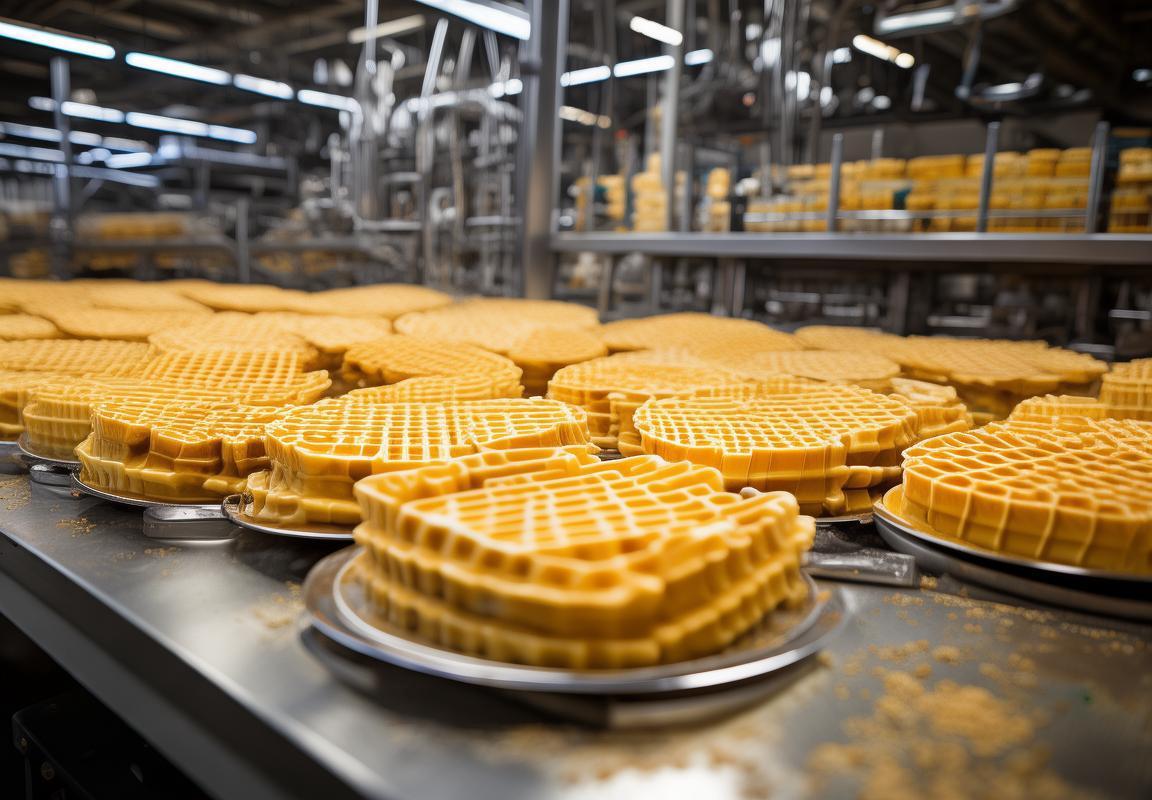
Maintenance and Upkeep: Keeping the Waffle Irons Rolling
In the bustling world of waffle production, the longevity and performance of waffle irons are paramount. Ensuring that these machines continue to roll out perfect waffles day in and day out requires a meticulous maintenance and upkeep routine. Here’s how it’s done:
Regular Cleaning and SanitizingThe heart of any waffle iron is its plates, and keeping them clean is non-negotiable. Every shift begins with a thorough cleaning of the plates, using a non-abrasive cleaner to remove any food particles or residue. Sanitizing solutions are then applied to kill any bacteria or germs that may have accumulated. This routine not only preserves the flavor and quality of the waffles but also extends the life of the irons.
Preventive InspectionsBefore the waffle iron plant starts its daily production, preventive inspections are conducted. This includes checking the electrical connections for any signs of wear or damage, ensuring that the heating elements are functioning correctly, and verifying that the plates are properly aligned. Any minor issues are addressed immediately to prevent them from escalating into major problems later on.
Regular LubricationThe moving parts of waffle irons, such as hinges and springs, require regular lubrication to operate smoothly. Technicians use high-temperature, food-grade lubricants to keep these components in good working order. This not only ensures a consistent production flow but also reduces the risk of mechanical failures.
Temperature ControlMaintaining the right temperature is crucial for waffle production. The heating elements in the irons are calibrated to a precise temperature that ensures even cooking. Regular checks are made to ensure that these elements are delivering consistent heat. If a discrepancy is detected, the temperature is adjusted, and the elements are cleaned to prevent any buildup that could lead to uneven cooking or damage.
Replacement of Wear PartsOver time, certain parts of the waffle irons may wear out due to constant use. Regular maintenance includes inspecting these parts and replacing them as needed. This could involve worn-out hinges, gaskets, or heating elements. By replacing these parts before they fail, the plant avoids costly downtime and maintains the quality of the waffles.
Calibration of Measurement DevicesAccurate measurement of ingredients is vital for consistent waffle production. Regular calibration of the measuring devices, such as scales and timers, ensures that the correct amount of batter is dispensed and cooked to perfection. This consistency is what keeps customers satisfied and the brand’s reputation intact.
Documentation of Maintenance ActivitiesEvery maintenance activity is meticulously documented. This includes the date of the inspection, the parts checked, any issues found, and the actions taken. This documentation serves as a record of the waffle iron’s maintenance history, which is crucial for troubleshooting and for compliance with health and safety regulations.
Employee TrainingThe people operating the waffle irons are the unsung heroes of the production line. Regular training sessions are held to ensure that they are familiar with the correct operation and maintenance procedures. Employees learn how to handle emergencies, such as a power outage or a malfunctioning iron, and they are equipped with the knowledge to perform basic maintenance tasks.
Scheduled OverhaulsWhile daily maintenance keeps the waffle irons running smoothly, scheduled overhauls are necessary to perform deeper repairs and replacements. These overhauls might include replacing worn-out motor belts, cleaning the exhaust system, or upgrading software for better control and monitoring. These periodic interventions ensure that the waffle irons are always up to date and efficient.
By adhering to this comprehensive maintenance and upkeep routine, the waffle iron plant can keep its machines in peak condition, ensuring a continuous flow of high-quality waffles. It’s this unwavering commitment to excellence that keeps the waffle irons rolling and the customers coming back for more.
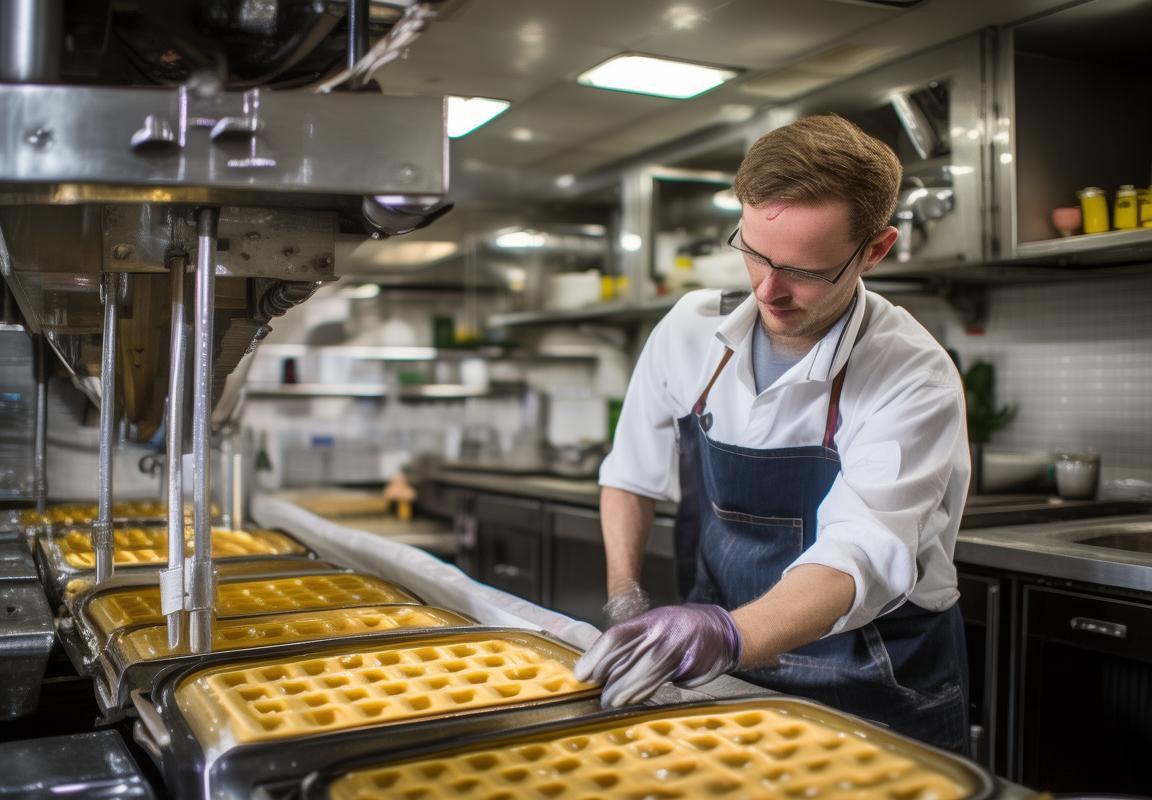
Case Studies: Success Stories from Continuous Operation Plants
The continuous operation waffle iron plant has become a cornerstone in the production of these delightful breakfast treats. From its inception, it has been designed with efficiency and reliability at its core. Here are some case studies that showcase the success stories from these plants:
In one such plant, the seamless integration of advanced technology has revolutionized the waffle-making process. The plant operates around the clock, producing a steady stream of perfectly golden waffles. The automated systems ensure that each batch meets the highest quality standards, thanks to the meticulous calibration of temperature and pressure controls.
Another success story comes from a plant that has implemented a unique recycling system. After the waffles are cooked, the residual batter is collected and repurposed, reducing waste and minimizing the plant’s environmental footprint. This innovative approach has not only boosted the plant’s sustainability but also improved its operational efficiency.
One plant in the southeastern region has gained recognition for its commitment to local sourcing. By procuring ingredients from nearby farms, the plant has not only supported the local economy but also reduced transportation costs and emissions. This strategy has allowed the plant to offer competitive pricing without compromising on quality.
In a northern location, a continuous operation plant has stood out for its flexibility in production. The facility can quickly adapt to changing consumer preferences by modifying its product lines. Whether it’s introducing new flavors or switching to gluten-free options, the plant’s dynamic production setup ensures that it remains at the forefront of market trends.
Another case study involves a plant that has embraced the power of data analytics. By continuously monitoring production data, the plant has been able to identify patterns and optimize its processes. This has led to a reduction in downtime and an increase in output, making the plant one of the most productive in the industry.
In a coastal town, a waffle iron plant has made a name for itself through its dedication to community engagement. The plant actively participates in local events, providing free samples and educational workshops on waffle-making. This community-oriented approach has fostered brand loyalty and generated positive word-of-mouth, enhancing the plant’s reputation.
One plant has also been lauded for its investment in employee training and development. Recognizing that skilled labor is crucial for its success, the plant offers comprehensive training programs to its workforce. This commitment to employee growth has translated into higher job satisfaction and a more engaged workforce, contributing to the plant’s ongoing success.
In another instance, a continuous operation plant has implemented a rigorous quality control system. Every waffle that leaves the facility is inspected by a team of dedicated quality assurance professionals. This unwavering attention to detail has resulted in a product that consistently meets or exceeds customer expectations.
Several plants have also taken advantage of the latest in energy-efficient technologies. By utilizing solar panels and advanced insulation, these plants have significantly reduced their energy consumption. This not only lowers their operational costs but also demonstrates a commitment to sustainability and environmental responsibility.
One plant has even gone a step further by investing in a state-of-the-art waste-to-energy system. The plant converts its food waste into biogas, which is then used to generate electricity. This innovative approach has not only helped the plant achieve a carbon-neutral operation but also set a precedent for other manufacturers looking to minimize their environmental impact.
The success stories from continuous operation waffle iron plants are a testament to the ingenuity and dedication of the companies behind them. By focusing on efficiency, sustainability, community, and employee well-being, these plants have not only thrived but also set new standards for the industry. As consumer demands evolve, these plants continue to adapt and innovate, ensuring that the joy of waffles remains a staple in kitchens around the world.
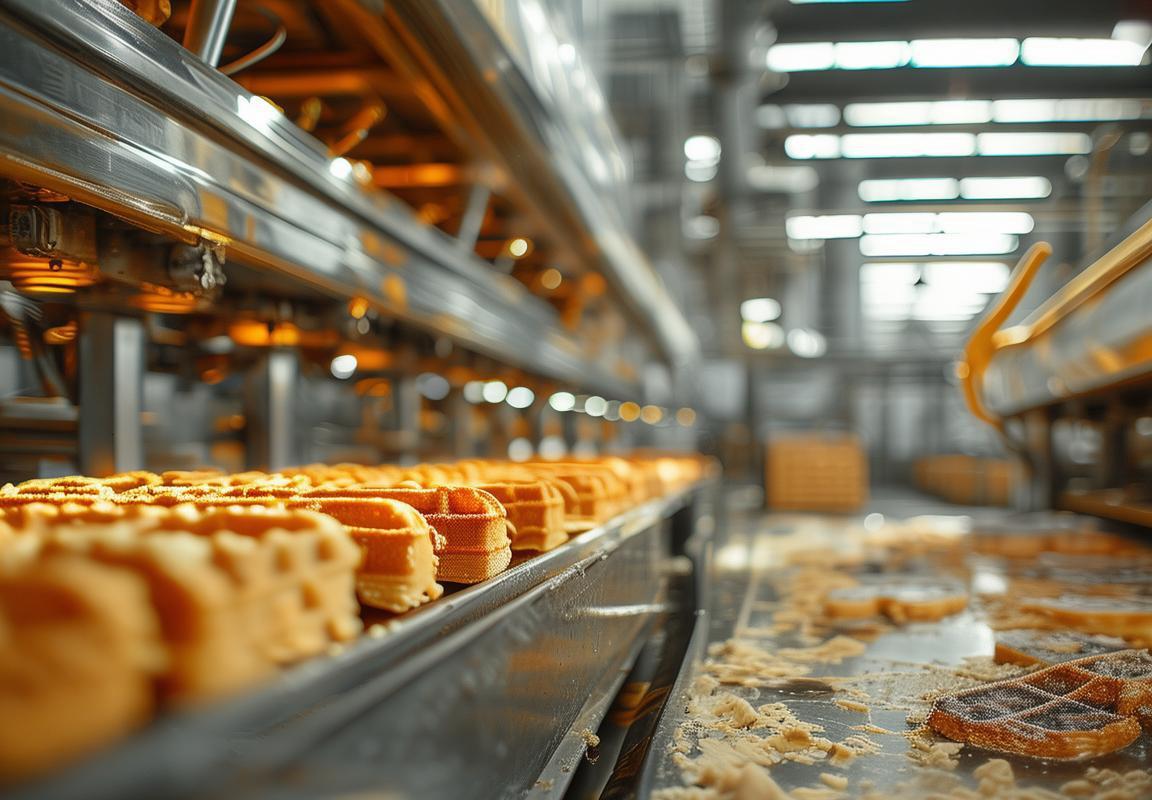
Future Trends and Potential Developments in the Industry
In the ever-evolving landscape of the food industry, the future of continuous operation waffle iron plants is as promising as it is innovative. As we delve into the potential developments and future trends, it’s clear that technology, sustainability, and consumer preferences will shape the industry’s direction.
The integration of smart technology is already making waves in the manufacturing sector, and the waffle iron industry is no exception. Imagine a scenario where predictive maintenance algorithms can predict equipment failures before they occur, ensuring minimal downtime and maximizing production. This level of foresight is not just a convenience; it’s a necessity in a 24⁄7 operation.
Sustainability is another driving force. As the world becomes more environmentally conscious, companies are under pressure to reduce their carbon footprint. Continuous operation plants are already designed to minimize waste and energy consumption, but the future holds even more ambitious goals. We could see the rise of eco-friendly materials in the construction of these plants, as well as the development of renewable energy sources to power them. Solar panels and wind turbines might become standard features, not just as a novelty but as a cornerstone of operational efficiency.
Consumer demands are shifting, and with them, the industry must adapt. The rise of health consciousness has led to a demand for healthier waffle options, with fewer calories, less sugar, and more whole grains. Continuous operation plants will need to invest in versatile machinery that can quickly switch between recipes, ensuring that the market remains catered to these evolving tastes.
Personalization is another trend that’s poised to make a significant impact. Customization isn’t just for high-end restaurants; it’s becoming a staple in mass production. Imagine a system where customers can order their waffles with a variety of toppings and flavors, and the plant can produce them on the fly. This requires a high degree of flexibility in the production line, possibly even incorporating 3D printing technology to create unique waffle shapes and patterns.
The logistics of continuous operation are also subject to change. As demand for quick-service waffles increases, so does the need for efficient distribution networks. We might see the development of a “just-in-time” inventory system where ingredients are delivered directly to the plant, reducing waste and ensuring freshness. This could lead to a more localized approach, with plants situated closer to consumers to minimize transportation costs and carbon emissions.
The industry is also likely to see a rise in collaborative efforts. Smaller players might find it more cost-effective to join forces with larger companies, sharing resources and expertise. This could lead to the creation of specialized plants that focus on niche markets, offering premium, artisanal waffles that are handcrafted using traditional methods.
As for the workforce, the future will demand a skilled labor pool that can operate and maintain the sophisticated machinery. Continuous education and training programs will be crucial, ensuring that employees are up-to-date with the latest technologies and safety protocols. This could also open doors for a new generation of engineers and technicians who are passionate about food production and sustainability.
The rise of e-commerce and online ordering platforms will also play a significant role in the future of the industry. Continuous operation plants may need to invest in packaging solutions that can withstand long-distance shipping while keeping the waffles fresh. This could involve the development of innovative packaging materials that provide a protective environment for the waffles, ensuring they arrive at the consumer’s doorstep in perfect condition.
In conclusion, the future of the continuous operation waffle iron industry is bright, with a myriad of opportunities for innovation and growth. As technology advances, sustainability becomes a priority, and consumer preferences evolve, the industry will continue to adapt and thrive, offering a delicious and efficient solution to the world’s love for waffles.